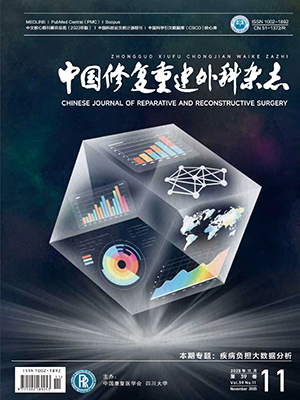Objective To investigate and compare the effectiveness of perichondrial cutaneous graft (PCCG) of dorsal auricle for repairing defect after excision of melanocytic nevus in different parts of the face. Methods Between February 2008 and October 2012, 29 cases of facial melanocytic nevus were admitted. There were 11 males and 18 females, aged 3-25 years (median, 11 years). The locations were the upper eyelid in 5 cases, the nose in 15 cases, and the buccal region in 9 cases. The size of the nevi ranged from 1.2 cm × 1.0 cm to 4.0 cm × 2.2 cm. Defects after excision of nevi were repaired by PCCG of the dorsal auricle, which size ranged from 1.5 cm × 1.5 cm to 4.2 cm × 2.5 cm. The postoperative effectiveness was scored by patients according to color match, scar formation, and flatness of the reception site. The satisfaction evaluations were compared by the score among different parts. Results All the PCCG survived. All the patients were followed up 7-15 months (mean, 10 months). All the reception site had good color match and acceptable scar formation. The nasal part had good flatness, and the upper eyelid had poor flatness. Score comparison showed no significant difference in color match between 3 parts (P gt; 0.05). Nasal part had significantly less scar formation than buccal region and upper eyelid (P lt; 0.05), but no significant difference between buccal region and upper eyelid (P gt; 0.05). Nasal part and buccal region both had significantly better flatness than upper eyelid (P lt; 0.05), but no significant difference between nasal part and buccal region (P gt; 0.05). The overall evaluation score of nasal part and buccal region was significantly higher than that of the upper eyelid group (P lt; 0.05), and the score of the nasal part was significantly higher than that of the buccal region (P lt; 0.05). Conclusion PCCG of dorsal auricle has a good color match in repair of facial defect, especially in repair of nasal defect with good flatness and no obvious scar formation.
Citation: DUAN Weiqiang,CEN Ying.. EFFECTIVENESS OF PERICHONDRIAL CUTANEOUS GRAFT OF DORSAL AURICLE FOR REPAIRING FACIAL MELANOCYTIC NEVUS EXCISION DEFECT. Chinese Journal of Reparative and Reconstructive Surgery, 2013, 27(11): 1350-1354. doi: 10.7507/1002-1892.20130293 Copy
Copyright ? the editorial department of Chinese Journal of Reparative and Reconstructive Surgery of West China Medical Publisher. All rights reserved




